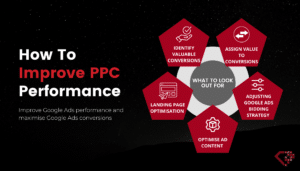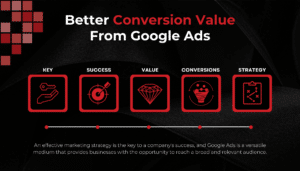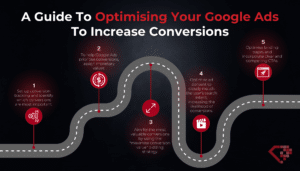[et_pb_section fb_built=”1″ _builder_version=”4.16″ global_colors_info=”{}”][et_pb_row _builder_version=”4.16″ background_size=”initial” background_position=”top_left” background_repeat=”repeat” global_colors_info=”{}”][et_pb_column type=”4_4″ _builder_version=”4.16″ custom_padding=”|||” global_colors_info=”{}” custom_padding__hover=”|||”][et_pb_text _builder_version=”4.16″ background_size=”initial” background_position=”top_left” background_repeat=”repeat” global_colors_info=”{}”]
In today’s digital world, effective marketing is key to the success of your business. One essential aspect of successful marketing is gaining valuable conversions, actions taken by your audience that provide value to your company, such as a purchase or a sign-up. These conversions are more than mere numbers – they signify customer engagement and potential for growth.
One strategy that can dramatically increase your conversions is the use of Google Ads advertising. This tool is a versatile platform that enables you to showcase your products or services to a large and relevant audience, significantly boosting your visibility and engagement. As part of your marketing strategy, Google Ads can be incredibly efficient, provided you use it effectively. By targeting the right people at the right time and providing them with the right information, you can ensure that you maximise the conversion value from your campaigns.
In this blog, we’re going to delve into how to get better conversion value from Google Ads, discussing the importance of identifying valuable conversions, assigning values to these conversions, adjusting your bidding strategy, optimising your ad content, and refining your landing page. We’ll also explore some of the best Google Ads bidding strategies, along with the latest Google Ads trends, and how to utilise Google Ads conversion tracking effectively. Let’s get started!
How To Improve PPC Performance
In the following sections, we’ll look at how to improve Google ads performance and maximise Google Ads conversions.
#1 – Identify Valuable Conversions
Effective Google Ads performance starts with identifying valuable conversions. What is a conversion in this context? It’s an action that a user takes on your website, like making a purchase, submitting a contact form, or signing up for a newsletter. In essence, conversions are proof that your advertising is working – they indicate that a customer has moved beyond just viewing your ad and has interacted with your business in a meaningful way.
When it comes to conversion tracking in Google Ads, there are primary conversions and secondary conversions. Primary conversions are the main actions you want users to take on your website, like making a purchase or booking an appointment. These are the conversions that you’ll use to optimise your bid strategy and that Google Ads will aim to increase.
Secondary conversions, on the other hand, are the additional actions that users might take that still add value, but are not the main goal of your advertising campaign. These could include actions like newsletter signups or downloading a brochure. These are worth tracking to get a fuller picture of your customer engagement, but won’t directly influence your bid strategy.
Identifying the most valuable conversions when setting up conversion tracking will depend on your business’s unique objectives. The action with the most intent, or the one that most directly leads to a profitable customer interaction, is often considered the most valuable. For example, for an e-commerce store, a completed sale would likely be the most valuable conversion, while a service-based business might value a booking or consultation request highest.
Once you’ve identified your most valuable conversion touchpoints, you can then look to assign specific values to these conversions. The aim is to prioritise these high-value actions in your Google Ads strategy, helping to maximise your return on ad spend. By tracking these valuable conversions, you will gain a deeper understanding of your customers’ behaviour, empowering you to make more informed marketing decisions, and leading to improved PPC performance.

#2 – Assign Value to Conversions
Once you’ve identified your valuable conversions, the next step is to assign a monetary value to each of these actions. Assigning values to conversions is a crucial step as it helps prioritise valuable conversions. By doing this, you’re essentially telling Google that a conversion with a higher value is more important to your business. This helps Google Ads optimise your bidding strategy in favour of gaining these higher-value conversions.
Assigning a value to a conversion is fundamentally based on the monetary worth you associate with that specific conversion action. For instance, if the primary lead action on your website is a booking form submission, you might choose to assign a value of R150.00 to this action. This suggests to Google that every time someone completes a booking form, it’s as if you’ve made R150.00. On the other hand, a secondary action such as a contact form submission, which might indicate a lower level of intent, could be assigned a lower value.
This process is not random but should be based on careful analysis of your business data and objectives. The value you assign to a conversion should ideally represent the potential profit that conversion brings to your business.
In determining the values to assign to each conversion action, historical data can be very helpful. Look at your past campaign results, customer behaviour, and the revenue generated from past conversions. How many of each conversion action have you previously seen? How much revenue did these actions bring in? This information can guide you to estimate a reasonable value for each conversion.
Remember, assigning conversion values isn’t a ‘set and forget’ process. Regularly reviewing and updating conversion values to reflect current trends, market conditions, and your latest business data will keep your Google Ads campaigns aligned with your business goals and ensure you are optimising for the most profitable actions.
#3 – Adjusting Google Ads Bidding Strategy
Now that you’ve identified and assigned values to your conversions, it’s time to consider how to optimise your bidding strategy. One effective strategy is to “maximise conversion value,” which allows Google Ads to automatically adjust your bids to gain the most valuable conversions based on the monetary values assigned.
The “maximise conversion value” strategy operates under the premise that not all conversions are equal, some are more valuable than others. Therefore, it uses machine learning to analyse a wide range of signals, including device and location, at auction-time and adjusts your bids in real-time. This means that it could potentially place a higher bid for auctions that are likely to yield a larger conversion value, compared to those auctions with less perceived value. The end goal is to gain the highest total conversion value possible within your specified budget.
This bidding strategy has the potential to significantly increase conversions that truly matter to your business by focusing on gaining higher value conversions. The direct implication of this is an improved Return on Investment (ROI). By prioritising higher-value conversions, you are ensuring that your ad spend is efficiently allocated towards actions that are more likely to drive business growth and profitability.
However, like all aspects of Google Ads management, it’s important to actively monitor and adjust your bidding strategy based on your campaign performance. You should observe the number and value of conversions you’re gaining and compare this with your ad spend. Are you seeing an acceptable return? Are there any trends or patterns in the conversion data that might suggest ways to refine your conversion values or bidding strategy?
When assessing your campaign performance, strive to find a balance or a “sweet spot” – a point where you gain a good number of higher value conversions without completely neglecting other lower intent conversions. Remember, some lower-value conversions might still have value in terms of building customer relationships or generating repeat business.

#4 – Optimise Ad Content
Your ad copy plays a crucial role in the overall success of your Google Ads campaign. Not only does it serve as a direct communication tool to your potential customers, but it also significantly influences your ad relevance. Ad relevance is a measure of how closely your ad aligns with the intent behind a user’s search. When your ad content resonates with what a user is looking for, it greatly increases the likelihood of a click, leading to higher conversion rates.
One essential aspect of creating relevant ad copy is the strategic use of keywords. Keywords are the backbone of any successful Google Ads campaign. When writing your ad copy, you should include the keywords you’re bidding on. This not only increases the relevance of your ad but also shows the user that your ad directly addresses their query.
However, be careful to not simply stuff your ad copy with keywords. Your ad text should read naturally and clearly communicate the value of your offering to the user. Remember, your goal isn’t just to get clicks, but to attract the right kind of clicks that can lead to valuable conversions.
Use ad extensions, such as sitelink extensions, to provide additional relevant information to users. Ad extensions can effectively expand your ad with more places to click, giving users more reasons to choose your business. Sitelink extensions, in particular, allow you to link to specific pages on your website, which not only improves the user experience by taking users directly to what they’re looking for, but also creates additional opportunities for conversions.
#5 – Landing Page Optimisation
The landing page plays a crucial role in your Google Ads conversion journey. It’s the place where your potential customers first arrive after clicking on your ad, and can significantly influence whether they choose to convert or not.
One fundamental aspect of landing page optimisation involves ensuring its relevance to the user’s search intent. Just like your ad copy, your landing page should contain the same keywords you’re bidding on in your Google Ads campaign. When users see a correlation between their search query, your ad, and the landing page, they’re more likely to engage with your page and complete the conversion action. Irrelevant landing pages can lead to higher bounce rates and fewer conversions.
Another vital aspect of landing page optimisation is page load speed. Users have little patience for slow-loading websites. If your landing page takes too long to load, potential customers might bounce off your site before even seeing what you have to offer. Therefore, it’s crucial to ensure that your landing page loads quickly, providing a smooth user experience and reducing the chances of users leaving your site prematurely.
Finally, your landing page must have clear and compelling Call-to-Actions (CTAs). Your CTAs guide users towards the conversion action you want them to take, be it filling out a form, making a purchase, or downloading a resource. To drive better conversion results, make sure your CTA buttons are placed prominently on your landing page, right where users land. They should be visually striking, use action-oriented text, and clearly communicate what users can expect once they click.

In Conclusion
Optimising your Google Ads for better conversion value is an essential aspect of any successful digital marketing strategy. From identifying valuable conversions, assigning appropriate values to these conversions, adjusting your bidding strategy, creating relevant and compelling ad content, to optimising your landing pages, every element plays a crucial role in influencing your Google Ads performance and overall Return On Ad Spend (ROAS).
- Start by correctly setting up conversion tracking and identify which conversions matter the most to your business.
- Assign monetary values to these conversions to help Google Ads understand their importance and prioritise them.
- Utilise the “maximise conversion value” bidding strategy to aim for the most valuable conversions.
- Create relevant ad content that closely matches the user’s search intent, enhancing the likelihood of ad clicks and conversions.
- Lastly, optimise your landing pages to match the user’s search intent, provide fast loading speeds, and incorporate clear and compelling call-to-actions.
These strategies offer a holistic approach to improving your Google Ads performance, helping your business reach its most valuable customers, maximise ROI, and drive sustainable growth.
If you’re feeling overwhelmed or unsure about how to improve PPC performance, Ruby Digital is here to help. Our team of digital marketing experts is ready to assist you in setting up, managing, and optimising your campaigns to improve Google Ads performance and drive better conversion value. Reach out to us today to get started on your journey towards Google Ads success!
Maximise Google Ads Conversion FAQ1. What is the maximise conversion bidding strategy?This is a Google Ads automated bidding option that seeks to get as many conversions as possible within your set budget using machine learning algorithms. 2. How does maximise conversion work?Maximise conversion bidding strategy uses real-time data on various factors like device, location, and time of day to adjust your bids automatically, driving the most conversions for your campaign. 3. When should I use maximise conversions?Use this strategy when your main goal is to get as many conversions as possible, irrespective of the cost per conversion. 4. What is bid adjustments on maximise conversion value?Bid adjustments allow you to alter your bids based on the relative conversion value your ads generate, optimising the value derived from your budget. |
Remember, to find the best bid strategy for Google ads for your brand, constant adjustments based on performance are crucial. If you need expert help, the Ruby Digital team is ready to assist!
[/et_pb_text][/et_pb_column][/et_pb_row][/et_pb_section]




